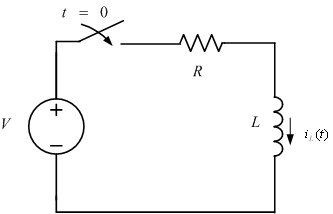RL Circuits
RL Circuits CLAIMED BY VJ SERVERA
The Main Idea
An RL circuit is one that contains resistors and inductors. The simplest type of these circuits involves one resistor and one inductor, and is called a first order RL circuit. The order of the circuit is equal to the number of inductors involved in the circuit. In this section we will study the following circuit:
A Mathematical Model
First we must remember the relationship between current going through an inductor and the voltage drop across it. The relationship is simply
[math]\displaystyle{ {L\frac{d\vec{i}}{dt}} = \vec{v(t)} }[/math]
meaning that the derivative of the current going through the inductor is proportional to the voltage drop across it. The proportionality constant is the inductance [math]\displaystyle{ L }[/math].
Before the switch closes, we know there is no current going through the inductor , and therefore no voltage. The initial conditions are:
[math]\displaystyle{ v(0) = 0 }[/math]
[math]\displaystyle{ i(0) = 0 }[/math]
Now applying Kirchoff's Voltage Law (loop-rule) we obtain the first order differential equation:
[math]\displaystyle{ V = iR + L\frac{di}{dt} }[/math]
Now we solve the equation. Rearranging:
[math]\displaystyle{ \frac{di}{dt} = \frac{V-iR}{L} }[/math]
[math]\displaystyle{ \frac{di}{V-iR} = \frac{dt}{L} }[/math]
Integrating both sides:
[math]\displaystyle{ -\frac{\ln(V-iR)}{R} = \frac{t}{L} + K }[/math]
Since [math]\displaystyle{ i = 0 }[/math] when [math]\displaystyle{ t = 0 }[/math], plugging these values in gives us
[math]\displaystyle{ K = -\frac{\ln(V)}{R} }[/math]
Substituting K back into our equation, getting rid of the denominator, and collecting the logarithms, we have
[math]\displaystyle{ \ln(\frac{V-Ri}{V}) = -\frac{R}{L}t }[/math]
Exponentiating both sides and solving for [math]\displaystyle{ i }[/math]
[math]\displaystyle{ i = \frac{V}{R}(1 - \exp(-(\frac{R}{L}t))) }[/math]
A Computational Model
This simple online applet shows how the current through the inductor behaves as time passes. Eventually, the inductor acts as a straight wire and the curren through it is constant.
Examples
Be sure to show all steps in your solution and include diagrams whenever possible
Simple
Middling
Difficult
Connectedness
1. How is this topic connected to something that you are interested in?
Im interested in how brain waves are read through EEGs. EEGs involve RL circuits to read brain signals properly and give that information to the viewer.
2. How is it connected to your major?
In biology, microscopes are used a lot to view cells and other extremely small objects. Some hardware additions to microscope use RL circuits to help images appear more clear to the viewer.
3. Is there an interesting industrial application?
RL circuits are used universally; anywhere signals from the outside, such as noise or light, are used for data or analysis, RL circuits allow for hardware to recieve these signals and filter out the ones that are important.
History
In the mid-19th century, Joseph Henry discovered the principle of self inductance. By wrapping coil around a magnet and sending a current through the coil, he realized that a magnetic field was created and energy could be stored in it through the "induced" voltage that is generated across the inductor. The history of inductors can be best shown through their many applications since their discovery. One of the most important applications that has been used almost universally in electronics and hardware since the 1800s was the filter. A filter is a circuit, which contains a combination of resistors, inductors, and capacitors, that can block signals of certain frequencies and let pass signals of other frequencies. This concept is heavily utilized in many fields; for example, in telecommunications, phones must contain filters that only let frequencies that come from the human voice pass through, and reduce other noise.
Another application of inductors lies in transformers. Transformers "transform" voltages from low to high and high to low. This is important because power plants store energy at very high voltages and low currents in order to minimize loss of energy. These voltages can get as high 750,000 volts. Of course, home appliances barely need a fraction of that. Inductors in circuits are used in transformers so that the high voltages from the power plants can be brought to lower, useable voltages.
See also
Are there related topics or categories in this wiki resource for the curious reader to explore? How does this topic fit into that context?
Further reading
Books, Articles or other print media on this topic
External links
Internet resources on this topic
References
This section contains the the references you used while writing this page
